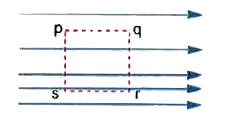Is an electric field of the type shown by the electric lines in fig. physically possible?
 .
.
Considera closed path p q r as shown in the given field

At pq field intensity is E1 and at rs field intensity is E2. From the given distribution of field lines E2>E1. Field is perpendicular to qr or ps
Now ∮¯¯¯E.d¯l=∫E1(pq)+∫E2(sr)
=(E1−E2)pq≠0
(∴∫¯¯¯E.d¯l=0 for qr and ps)
Line integral of ¯¯¯E.d¯l along closed path is nonzero in this case. But we know that electric field is conservative and ∮¯¯¯E.d¯l=0.
It means electric field as shown in not possible.
Topper's Solved these Questions
- ELECTRIC FIELD AND POTENTIALBOOK - AAKASH SERIESCHAPTER - ELECTRIC FIELD AND POTENTIALEXERCISE - EXERCISE (LONG ANSWER QUESTIONS)
3 Videos
- ELECTRIC FIELD AND POTENTIALBOOK - AAKASH SERIESCHAPTER - ELECTRIC FIELD AND POTENTIALEXERCISE - EXERCISE (SHORT ANSWER QUESTIONS)
6 Videos
- ELECTRIC CHARGES AND FIELDSBOOK - AAKASH SERIESCHAPTER - ELECTRIC CHARGES AND FIELDSEXERCISE - Practice Exercise
57 Videos
- ELECTROMAGNETIC INDUCTIONBOOK - AAKASH SERIESCHAPTER - ELECTROMAGNETIC INDUCTIONEXERCISE - Additional Exercise
11 Videos
Similar Questions
If electric field is uniform, then the electric lines of forces are :
View SolutionDue to an electric dipole shown in fig., the electric field intensity is parallel to dipole axis :

View SolutionFor the following electric field lines, the the electric field is

View SolutionWhich one of the following pattern of electric line of force can't possible:
View SolutionAn electron enters an electric field with its velocity in the direction of the electric lines of force. Then
View SolutionElectric flux over a surface in an electric field
View Solution(A ): A charged particle free to move in an electric field always move along an electric line of force.
(R ): The electric line of force diverge from a positive charge and converge at a negative charge.
View SolutionConsider the charge configuration and a spherical Gaussian surface as shown in the figure. When calculating the flux of the electric field over the spherical surface, the electric field will be due to.

View SolutionConsider the charge configuration and a spherical Gaussian surface as shown in the figure. When calculating the flux of the electric field over the spherical surface, the electric field will be due to.

View SolutionAssertion A point charge produces a uniform electric field.
Reason Due to a point charge, electric lines of forces are parallel and equidistant.
View Solution
